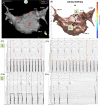STAR mapping method to identify driving sites in persistent atrial fibrillation: Application through sequential mapping
- PMID: 31552697
- PMCID: PMC6916564
- DOI: 10.1111/jce.14201
STAR mapping method to identify driving sites in persistent atrial fibrillation: Application through sequential mapping
Abstract
Introduction: The optimal way to map localized drivers in persistent atrial fibrillation (AF) remains unclear. The objective of the study was to apply a novel vector mapping approach called Stochastic Trajectory Analysis of Ranked signals (STAR) in AF.
Methods and results: Patients having persistent AF ablation were included. Early sites of activation (ESA) identified on global STAR maps created with basket catheters were used to guide AF ablation post-pulmonary vein isolation (PVI). All patients also had sequential STAR maps created with ≥10 PentaRay recordings of 30 seconds. These were validated offline in their ability to identify the ESA targeted with a study-defined ablation response (AF termination or cycle length [CL] slowing of ≥30 ms). Thirty-two patients were included in whom 92 ESA were identified on the global STAR maps, with 73 of 83 targeted sites demonstrating an ablation response (24 AF termination and 49 CL slowing). Sixty-one out of 73 (83.6%) ESA were also identified on the sequential STAR maps. These showed greater consistency (P < .001), were seen pre- and post-PVI (P < .001) and were more likely to be associated with AF termination on ablation (P = .007). The sensitivity and specificity of sequential mapping for the detection of ESA with an ablation response was 84.9% (95% confidence interval [CI] = 74.6-92.2) and 90.0% (95% CI = 55.5-99.8), respectively. During a follow-up of 19.4 ± 3.7 months, 28 (80%) patients were free from AF/atrial tachycardia.
Conclusions: STAR mapping consistently identified ESA in all patients and the ablation response was compatible with ESA being driver sites. Mechanistically important ESA were successfully identified using sequential recordings.
Keywords: atrial fibrillation; atrial tachycardia; catheter ablation; drivers; mapping.
© 2019 The Authors. Journal of Cardiovascular Electrophysiology published by Wiley Periodicals, Inc.
Figures





References
-
- Haissaguerre M, Hocini M, Denis A, et al. Driver domains in persistent atrial fibrillation. Circulation. 2014;130(7):530‐538. - PubMed
-
- Honarbakhsh S, Schilling RJ, Providencia R, et al. Characterization of drivers maintaining atrial fibrillation: correlation with markers of rapidity and organization on spectral analysis. Heart Rhythm. 2018;15:1296‐1303. - PubMed
-
- Narayan SM, Baykaner T, Clopton P, et al. Ablation of rotor and focal sources reduces late recurrence of atrial fibrillation compared with trigger ablation alone: extended follow‐up of the CONFIRM trial (Conventional Ablation for Atrial Fibrillation With or Without Focal Impulse and Rotor Modulation). J Am Coll Cardiol. 2014;63(17):1761‐1768. - PMC - PubMed
-
- Lee G, Kumar S, Teh A, et al. Epicardial wave mapping in human long‐lasting persistent atrial fibrillation: transient rotational circuits, complex wavefronts, and disorganized activity. Eur Heart J. 2014;35(2):86‐97. - PubMed
Publication types
MeSH terms
Grants and funding
LinkOut - more resources
Full Text Sources
Medical

